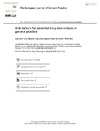Identificador persistente para citar o vincular este elemento:
https://accedacris.ulpgc.es/jspui/handle/10553/48482
| Campo DC | Valor | idioma |
|---|---|---|
| dc.contributor.author | Bjerrum, Lars | en_US |
| dc.contributor.author | González Lopez-Valcarcel, Beatriz | en_US |
| dc.contributor.author | Petersen, Gert | en_US |
| dc.date.accessioned | 2018-11-23T22:12:14Z | - |
| dc.date.available | 2018-11-23T22:12:14Z | - |
| dc.date.issued | 2008 | en_US |
| dc.identifier.issn | 1381-4788 | en_US |
| dc.identifier.uri | https://accedacris.ulpgc.es/handle/10553/48482 | - |
| dc.description.abstract | Objective: To identify patient- and practice-related factors associated with potential drug interactions. Methods: A register analysis study ingeneral practices in the county of Funen, Denmark. Prescription data were retrieved from a population-based prescription database (Odense University Pharmacoepidemiologic Database, OPED) covering prescriptions to all inhabitants in the county of Funen, Denmark. All individuals exposed to concurrent use of two or more drugs (polypharmacy) were identified. Combinations of drugs with potential interactions were registered and classified as major, moderate, or minor, depending on the severity of outcome and the quality of documentation. A two-level random coefficient logistic regression model was used to investigate factors related to potential drug interactions. Results: One-third of the population was exposed to polypharmacy, and 6% were exposed to potential drug interactions during 1 year. Patient factors associated with increased risk of potential drug interactions were high age, a high number of concurrently used drugs, and a high number of prescribers. Practice factors associated with potential drug interactions were a high percentage of elderly patients and a low percentage of female patients listed. Conclusion: Prescription data maybe useful in quality-improvement programmes to identify groups of patients and practices at increased risk of drug interactions. | en_US |
| dc.language | eng | en_US |
| dc.publisher | 1381-4788 | |
| dc.relation.ispartof | European Journal of General Practice | en_US |
| dc.source | European Journal of General Practice[ISSN 1381-4788],v. 14, p. 23-29 | en_US |
| dc.subject.other | Drogas | en_US |
| dc.subject.other | Sistema sanitario español | en_US |
| dc.title | Risk factors for potential drug interactions in general practice | en_US |
| dc.type | info:eu-repo/semantics/Article | en_US |
| dc.type | Article | en_US |
| dc.identifier.doi | 10.1080/13814780701815116 | |
| dc.identifier.scopus | 47149107043 | - |
| dc.contributor.authorscopusid | 7006017468 | - |
| dc.contributor.authorscopusid | 6507677112 | - |
| dc.contributor.authorscopusid | 7202922868 | - |
| dc.description.lastpage | 29 | - |
| dc.description.firstpage | 23 | - |
| dc.relation.volume | 14 | - |
| dc.investigacion | Ciencias Sociales y Jurídicas | en_US |
| dc.type2 | Artículo | en_US |
| dc.utils.revision | Sí | en_US |
| dc.date.coverdate | Julio 2008 | |
| dc.identifier.ulpgc | Sí | es |
| dc.description.scie | SCIE | |
| item.fulltext | Con texto completo | - |
| item.grantfulltext | open | - |
| crisitem.author.dept | GIR Economía de la salud y políticas públicas | - |
| crisitem.author.dept | Departamento de Métodos Cuantitativos en Economía y Gestión | - |
| crisitem.author.orcid | 0000-0002-5571-3257 | - |
| crisitem.author.parentorg | Departamento de Métodos Cuantitativos en Economía y Gestión | - |
| crisitem.author.fullName | González Lopez-Valcarcel, Beatriz | - |
| Colección: | Artículos | |
Citas SCOPUSTM
62
actualizado el 08-jun-2025
Visitas
110
actualizado el 28-dic-2024
Descargas
170
actualizado el 28-dic-2024
Google ScholarTM
Verifica
Altmetric
Comparte
Exporta metadatos
Los elementos en ULPGC accedaCRIS están protegidos por derechos de autor con todos los derechos reservados, a menos que se indique lo contrario.
